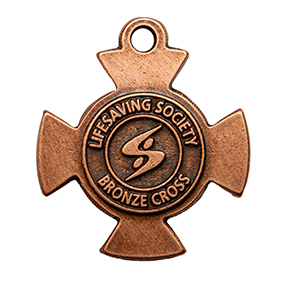Bronze Cross (20 hr.): begins the transition from lifesaving to lifeguarding and prepares candidates for responsibilities as assistant lifeguards. Candidates strengthen and expand their lifesaving skills and begin to apply the principles and techniques of active surveillance in aquatic facilities. Bronze Cross emphasizes the importance of teamwork and communication in preventing and responding to aquatic emergencies. Bronze Cross is a prerequisite for advanced training in the Society’s National Lifeguard and leadership certification programs.
Prerequisite: Bronze Medallion and Lifesaving Society Emergency or Standard First Aid certifications (need not be current) or EFA or SFA from one of these approved agencies.
Bronze Cross Exam Policy: Defines the minimum conditions under which Bronze level examinations may occur.
Read the current version of the Bronze Cross Examination Policy in the Policies section of our website.
:::

Instruction & certification: Current Lifesaving Instructors teach and evaluate most items, but only Bronze Examiners may certify candidates. The Lifesaving Society deems its certifications to be "current" for 24 months from the certification date.
Candidate recognition: Bronze Cross medal, Bronze Cross Award crest, certification card.
Required reference material: Canadian Lifesaving Manual. Bronze Cross Workbook recommended. (Note that some affiliates provide materials to candidates, and some require candidates to purchase materials on their own. Double check before you purchase.)
At-a-glance
Knowledge Items
- *The Lifesaving Society: Demonstrate knowledge of the Lifesaving Society as Canada’s lifeguarding experts.
- *Non-fatal drowning: Demonstrate knowledge of follow-up care and treatment of a conscious drowning victim.
- *Shallow water blackout: Demonstrate knowledge of the cause and prevention of shallow water blackout.
- *Assistant lifeguard roles and responsibilities: Demonstrate knowledge of the roles and responsibilities of an assistant lifeguard.
Skill Items
- *Communication: Demonstrate effective communication with patrons, victims, coworkers, supervisors, and emergency service personnel.
- *Two-rescuer removals: With a trained partner, demonstrate ability to remove victims from various aquatic environments including a removal with a spineboard.
- *Surface dives and underwater swims:
- Demonstrate a head-first surface dive (maximum depth 2 m) and swim underwater 10 m.
- Demonstrate a foot-first surface dive (maximum depth 2 m) and swim underwater 10 m.
- *†Team search: With bystanders, organize and participate in a logical underwater search of both a shallow and a deep-water area.
- *Two-rescuer drowning resuscitation: On a manikin, demonstrate two-rescuer adult, child, and infant drowning resuscitation including ability to deal with complications.
- *†Spinal injury management: Respond to a breathing or non-breathing suspected spinal-injured victim located in shallow water or on land.
- :::
Fitness Items
- *†Object recovery and transport: Demonstrate anaerobic fitness and strength for an object recovery: starting in the water, swim 15 m and surface dive to recover a 4.5 kg (10 lb.) object; surface and carry the object 5 m – all within 60 seconds.
- *†Rescue drill: Starting in the water, swim head-up to recover a submerged manikin or victim located 20 m away; surface and carry the manikin or victim 20 m to starting point – all within 120 seconds.
- *†Endurance challenge: Swim 400 m within 11 minutes (400 yd. in 9:40 minutes).
Judgment Items
- *Safety supervision scanning: While patrolling and scanning a supervised aquatic environment, identify deficiencies, hazards, and inappropriate patron behaviours or victim types. Intervene and verbally report as appropriate.
- †Two-person rescue 1 – multiple victims: Respond to an aquatic emergency in open water involving three or four victims and provide care until relieved of responsibility.
- †Two-person rescue 2 – submerged victim: Perform a rescue of a non-breathing victim submerged in deep water; remove victim and provide care until relieved of responsibility by a lifeguard. Perform CPR on a manikin.
- †Assistant lifeguard situations: As a member of an assistant lifeguard team, respond to an emergency in a supervised aquatic setting.
Note
- *Asterisk indicates instructor-evaluated item. The † symbol denotes the only items evaluated during a recertification.